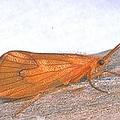 科學家發現一種被廣泛種植的基改玉米可能危及水域生態。研究顯示此基改玉米的花粉與植物碎片均帶毒性,一旦流入農田附近的河川,會對水生昆蟲石蠶蛾造成傷害,使魚類及兩棲類的食物來源減少。
科學家發現一種被廣泛種植的基改玉米可能危及水域生態。研究顯示此基改玉米的花粉與植物碎片均帶毒性,一旦流入農田附近的河川,會對水生昆蟲石蠶蛾造成傷害,使魚類及兩棲類的食物來源減少。
這類被稱為「Bt玉米」的基改品種帶有Bt菌的基因,會產生毒素讓玉米免於歐洲玉米螟等蟲害。由印第安那大學羅葉(Todd Royer)教授帶領的研究團隊發現,石蠶蛾與Bt玉米所針對的害蟲有親緣關係,在吃下玉米花粉、葉片及穗軸後,會有死亡率增高、生長遲緩的現象。
羅葉教授表示,「石蠶蛾是高等水生動物的食物來源,若希望河流生態系能健康運作,必須一併保護。」石蠶蛾的幼蟲也是河流生態系的重要成員,可以幫助控制藻類數量,並提供魚類另一種食源。在健康的溪流中石蠶蛾極為常見,會成千上百棲息於石頭及倒木底部。
Bt玉米在1996年獲准種植並迅速受到歡迎,美國於2006年已有超過35%的玉米田種植基改玉米。羅葉教授認為,「每種新科技都會同時帶來利益與風險。對於廣種Bt玉米可能造成的風險評估也許並不夠完善。」但他也表示,若種植基改玉米造成預料之外的後果,責任不該由農民承擔,因為在高度競爭的農業經濟中,生產者必須盡可能採用最佳技術。
這項研究發表在本週的美國國家科學院期刊(PNAS)。研究人員從2005年至2006年在農業密集的北印第安那州,測量流入12個上游溪流的Bt玉米花粉及碎片。他們也在石蠶蛾體內找到玉米花粉,證明石蠶蛾會攝食花粉。透過實驗室分析,研究員發現當石蠶蛾被餵食Bt玉米葉片,生長速度會減緩一半。
除了玉米之外,Bt基改技術也被用於馬鈴薯及棉花等作物。提倡者在宣傳Bt技術的優點時,也時常提及作物所含有的Bt蛋白質不會殺害益蟲,但此類論點顯然已被這項石蠶蛾研究結果所推翻。
A widely planted variety of genetically engineered corn has the potential to harm aquatic ecosystems. Pollen and other plant parts containing toxins from genetically engineered Bt corn are washing into streams near cornfields and harming a type of fly that is eaten by fish and amphibians, the study demonstrates.
Bt corn is engineered to include a gene from the micro-organism Bacillus thuringiensis, Bt, which produces a toxin that protects the crop from pests, especially the European corn borer. The research team led by Todd Royer, an assistant professor in the Indiana University School of Public and Environmental Affairs, found that consumption of Bt corn pollen, leaves and cobs increased mortality and reduced growth in caddisflies. aquatic insects related to the pests targeted by the toxin in Bt corn.
"Caddisflies," Royer said, "are a food resource for higher organisms like fish and amphibians. And, if our goal is to have healthy, functioning ecosystems, we need to protect all the parts." Caddisfly larvae are an important part of stream ecosystems, where they help control algae populations and provide food for fish and other creatures. In healthy streams, caddisflies are very common and their cases are found by the hundreds under rocks and logs.
Bt corn was licensed for use in 1996 and quickly gained popularity. By 2006, around 35 percent of corn acreage planted in the United States was genetically modified. "Every new technology comes with some benefits and some risks," he said. "I think probably the risks associated with widespread planting of Bt corn were not fully assessed." If there are unintended consequences of planting genetically engineered crops, Royer says farmers should not be held responsible. In a competitive agricultural economy, producers have to use the best technologies they can get, he said.
The study is published this week by the journal "Proceedings of the National Academies of Science, PNAS." Their research, conducted in 2005 and 2006 in an intensely farmed region of northern Indiana, measured inputs of Bt corn pollen, leaves and cobs in 12 headwater streams. They also found corn pollen in the guts of caddisflies, showing they were feeding on corn pollen. In laboratory trials, the researchers found caddisflies that were fed leaves from Bt corn had growth rates that were less than half those of caddisflies fed non-Bt corn litter.
Other crops such as potatoes and cotton also make use of Bt technology. When proponents of Bt technology list the benefits, they often say the Bt proteins in the crops will not kill beneficial insects. Royer and his team showed that claim is not accurate in the case of caddisflies.
全文及圖片詳見ENS




